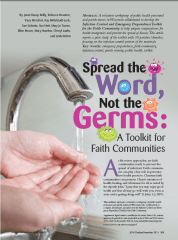By Shawn Kennedy, MA, RN, AJN editor-in-chief
Last week there was a disconcerting report from the Associated Press about a Catholic clergyman in North Dakota who may have inadvertently exposed many members of his church to hepatitis A. According to the report, the ill bishop had probably contracted the illness from contaminated food while attending a conference in Italy and, because he didn’t immediately feel ill (incubation period usually ranges from two to four weeks, though can be as long as eight weeks), continued to dispense communion at several area churches.
According to the Centers for Disease Control and Prevention (CDC) Web page for hepatitis A, infection “is primarily transmitted by the fecal–oral route, by either person-to-person contact or consumption of contaminated food or water.” A person is infectious from two weeks before to one week after the onset of symptoms. The FAQ page on the site does say, in regards to infected food handlers (which would seem to fit this case, in that the bishop handled communion hosts), that “transmission to patrons is unlikely”—and also offers some guidance for postexposure prophylaxis (PEP). In this case, too much time had elapsed: PEP needs to be given within two weeks of exposure.
 This situation made me wonder, though, as we’re about to enter peak flu season, if there are any infection control guidelines appropriate for religious services. Some faiths include taking communion or drinking from a communal cup, and many include shaking or clasping the hands of other congregants. Certainly these practices are ripe for transmission of bacteria and viruses. And if your church is anything like mine, there are many frail elderly people and families with infants and young children who would be at high risk.
This situation made me wonder, though, as we’re about to enter peak flu season, if there are any infection control guidelines appropriate for religious services. Some faiths include taking communion or drinking from a communal cup, and many include shaking or clasping the hands of other congregants. Certainly these practices are ripe for transmission of bacteria and viruses. And if your church is anything like mine, there are many frail elderly people and families with infants and young children who would be at high risk.
I asked a colleague, Kathy Schoonover-Shoffner, PhD, RN, the editor of the Journal of Christian Nursing, if she was aware of any guidelines. Well, it happens that her journal addressed this topic two years ago in an article in preparation for the H1N1 influenza pandemic: “Spread the Word, Not the Germs” (abstract only). The article discusses, among other related topics, the process of creating a free toolkit, Infection Control and Emergency Preparedness Toolkit for the Faith Community. (You can download the 200-page PDF document for free.)
The toolkit contains information for general use during services (such as making hand sanitizers available and encouraging their use, bowing instead of grasping hands, using individual cups and hosts instead of a communal cup or loaf) and has information and resources for use with parishioners of various ages and to help a congregation educate their members on preparedness. Much of the material in the toolkit is derived from state and federal public health resources and is therefore not specific to any one religious faith. It’s worth taking a look and perhaps bringing it to the attention of faith organizations in your community.

Comments are moderated before approval, but always welcome.